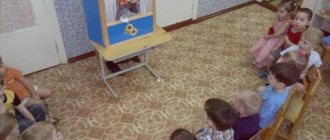Peculiarities of work activity of preschool children
It is important for adults not to miss the moment when children want to work and participate in household chores. This desire awakens in preschool age. With competent support, adults will be able to strengthen interest in work, while removing the child from work will gradually discourage him from wanting to work physically.
Why do mothers, fathers, and grandmothers often prefer to prohibit a child’s participation in any activity rather than support it? The reason is either increased anxiety for the child - lest he hurt himself, lest he harm himself while trying to manipulate the mop, reach the faucet, etc. Or adults are dissatisfied with the child’s inept actions, after which there will be even more washing and cleaning.
But you will have to come to terms with these moments if adults understand their own responsibility for instilling hard work in their little helper.
A characteristic feature of the work activity of a preschooler is that the child is focused not on a quality result, but on the immediate process. At preschool age, the need to take part in real life and be involved in the world of adults becomes actualized. This need can be realized by getting involved in specific activities.
This need is only partially realized in gaming activities. Children often simulate adult life in story-based games. But they understand that this is “make-believe.” And young people want real participation in real things that they observe every day at home or in kindergarten.
In labor, the child gets the opportunity to independently perform those actions that he previously only observed. By making efforts, the child believes that he, like an adult, is useful. That is why work activity is so attractive in preschool age.
Motives that encourage children to work
The motivation to put in work effort changes as the preschooler grows up. Motive is a structural component of any activity. Along with operations, it shapes the labor process from an early age. Other components of the work activity of preschoolers appear later.
Three- to four-year-old children are motivated by interest in the process itself. It’s so interesting to stir a ladle in a pan or move it with a vacuum cleaner brush.
In middle preschool age, children are pushed to do feasible work by incentives and reprimands . For example, a child is happy to wipe cutlery because his mother praises what a wonderful helper he is. In the same way, a preschooler quickly puts his toys in order, because after cleaning, dad promised to read a book together. Or the child independently begins to put together the scattered parts of the construction set so that his mother does not scold him.
The highest level in preschool age is social motives for work . Guided by these motives, children move from performing exciting actions or things for which they expect praise to actions that are important to other people.
Making a craft as a gift for mom, helping grandma water the garden bed, putting on shoes and tying shoelaces for a younger sister are examples of things that older preschoolers do in an effort to show concern for loved ones. In such cases, the question of whether the immediate process is interesting is not considered. The child realizes the value of his labor participation for the benefit of others. This is the right period to decide what the child should do around the house to help his parents.
Features of the work of a preschooler: how, why and why?
In preschool education, one of the main things is the organization and training in work activity and teaching many of its methods available to children in groups of this age. There has long been an expression among people that labor turned an ordinary animal (monkey) into a highly developed intelligent being (human). And, no matter how exaggerated these words sound, there is some truth in them.
In the process of organizing labor activity, organized and expedient, the child receives the necessary knowledge and skills, but this is not even the main benefit. Through the necessary actions performed by the body, the brain also develops, or rather, even the basic mental functions: thinking, perception, will. That is why labor education of preschool children is a very important and serious area.
Organization of work activities of preschool children
Work activities throughout preschool childhood become more complex, covering the path from mastering self-service skills to performing household duties and caring for plants and pets.
At 3-4 years old, even brushing your teeth or getting dressed for a walk on your own is difficult. With the development of manual skills, children's self-service skills are automated and move from the category of “work” into everyday actions. The work activity of a preschooler is filled with other processes involving the development of tools and the achievement of results.
The uniqueness of the work activities of younger preschoolers
It is clear that a 3-year-old child will persistently demand to be allowed to test in the kitchen in order to “help” make pies. But his interest will dry up in response to an offer to tidy up the gaming corner of his room.
The main reason is the lack of novelty, and therefore the lack of excitement in the process. Other, no less important reasons are added to it. The kid may simply not understand how to restore this very order...
In early preschool age, in order to introduce a child to work that is feasible for him, it is important to give specific and understandable instructions. “Put the cubes in a box, put the box on the shelf”, “Put your socks in a drawer” - after hearing such instructions, the baby will understand what they want from him at the moment, and will also gradually form a sequence for putting things in order.
Clear instructions are an essential element in developing a preschooler’s work skills.
Only by mastering the rules that allow him to organize his work will a preschooler be able to independently initiate and complete everyday work activities in the future.
Labor in older preschool age
Older preschoolers are introduced to work not for the sake of participation. Although there are also cases when 6-7 year old children are driven solely by curiosity: “How do you spin that? Let me try.” “I also want to dig” - the child takes up a shovel, but after a few attempts he loses the desire to do something that is quite physically difficult.
However, in most cases, all components of work activity can be traced in the activities of preschoolers: motive, goal, actual actions, control and evaluation . That is, the child sees the goal for applying his efforts, chooses the means, how he can get the result, performs the actions and is interested in the result of his work.
For example, 5-year-old Masha reports that she wants to sweep the room “to make it clean.” Having at least practiced with a broom, she collects the garbage in a dustpan and immediately asks if she swept well. Although the girl relies solely on praise for her efforts, she is interested in achieving her goal.
Mastering the components of work activity contributes to the development of the personal qualities of a preschooler. There is a direct influence on the formation of the following qualities:
- hard work
- responsibility
- independence
- perseverance
- criticality
Older preschoolers evaluate their work more objectively. They notice, unlike younger children, gross shortcomings and try to correct them. But it is important to them how an adult evaluates the quality of their work actions, so they ask appropriate questions.
Thanks to the development of speech, children in older preschool age are well able to perceive verbal instructions on how to perform a certain task. Adults will help the child if together they discuss the sequence of steps that will lead to the desired result.
Labor education of preschool children
“Education should not only develop the mind, equip with knowledge,
but also to ignite in a person a thirst for serious work,
without which his life can be neither worthy nor happy.”
K. D. Ushinsky
Labor education, that is, involving children in independent and feasible work and observing the work of adults, explaining its significance in people’s lives, plays an important role in the comprehensive development of the child’s personality, and the immediate future of the school student.
The main goal of the labor education system is the moral, psychological and practical preparation of children for work, the formation of a positive attitude towards it.
Interest in work, the necessary work skills and personal qualities are established in childhood. The task of teachers and parents is not to miss this moment, because preschool age is a responsible and fertile time when a child joyfully discovers the wonderful world of the surrounding reality. For him, the joy of being, the joy of learning, the joy of growing up is a normal state.
The work activity of a preschool child differs from the productive and domestic work of adults. It does not lead to an objectively significant product, but it is of great importance for the mental development of the child himself.
In order for hard work to become a stable trait, adults need to ensure that the preschooler systematically exercises, performing various work activities, and strives to fulfill his plans as best as possible.
Particular attention is required when assessing the work of a child, for whom it is extremely important to find out the opinion of an adult, experienced and authoritative person about how successfully he completed the work, what results he achieved, why and for whom they are important.
Work should enter a child’s life joyfully and help in successful all-round development.
At the same time, we must not forget that the success of labor education is impossible without special attention to the individuality of the child. After all, every person, including small ones, is a unique, peculiar personality with his own interests, affections, capabilities, and character traits.
Labor education is aimed at achieving the goal of forming a positive attitude towards work through solving the following tasks: development of labor activity; nurturing a value attitude towards one’s own work, the work of other people and its results, the formation of primary ideas about the work of adults, its role in society and the life of each person.
The leading principles for achieving the goal are:
— the principle of humanity (personal approach to the child);
— the principle of non-violence (voluntary participation of children in labor, emotional intensity of child labor);
— the principle of integrity (the personality of a preschooler is considered as an integral phenomenon, and the nature of the work activity of preschoolers is multifaceted);
— the principle of subjectivity (subjective-subjective interaction between a teacher and a child in the process of introducing a preschooler to work).
The necessary methods and techniques that are used to manage various types of child labor are the following:
- determine the purpose of work;
- help the child motivate his work;
— teach elements of work planning;
— learn to achieve results and evaluate them.
Labor is a complex activity. Since ancient times, the inclusion of a child in the working life of the family began very early. From infancy, an awareness of work as an integral and natural part of life was formed.
The problem of introducing preschoolers to work has found a worthy place in the works of outstanding teachers of the past.
A.S. Makarenko considered the child as a future member of the work team. He considered one of the main tasks of labor education to be the formation in children of a creative attitude to work. Speaking about the work of young children, A.S. Makarenko pointed out its close connection with play, which should gradually turn into work.
V.A. Sukhomlinsky wrote that childhood should not be a constant holiday. If there is no labor stress that is feasible for children, the joy of work remains inaccessible to the child.
K.D. Ushinsky considered the main tasks of education in work and for work to be instilling in children respect and love for work, along with the habit of working.
According to its content, the work of preschool children is divided into four types:
— self-service;
— household work;
- labor in nature;
- manual labor.
Various types of work are not the same in their pedagogical capabilities, their meaning changes at one or another age stage.
The content of work is realized in different forms of organization of preschool children: assignments, duties, duty, individual work, work nearby, collective work, common work, joint work.
The implementation of the tasks of labor education of a preschooler is possible only if there are conditions under which labor becomes a means of pedagogical influence:
— systematic inclusion of each child in labor;
— selection of equipment for work;
- taking into account the load on the child;
- an example of a teacher.
Thus, work has a great pedagogical impact only if it is properly organized.
In our work, we pay great attention to familiarizing children with the work of adults, as this forms an idea of the role of work in people’s lives and fosters a desire to participate in it.
The goal that we have set for ourselves is the following: the formation of children’s ideas about the world of professions and a positive attitude towards work.
We have identified a number of problems that need to be solved:
— development of labor activity;
- development of interest in the professions of parents and the most common professions of the immediate environment and the desire to follow the actions of adults;
- formation of an idea of the objective world created by human hands, of the role of man in it;
- developing children’s ideas about different professions, showing the importance of the professional activities of adults for society and children;
- teach children to reflect in role-playing games the features inherent in various professions
- to form in children a conscientious attitude towards work;
— to cultivate respect for the results of the work of people of different professions.
The activities of adults serve as role models for children, which is confirmed by their role-playing games. Children enthusiastically play “Barbershop”, “Steamboat”, “Construction site”, “Hospital”, “Shop”, betraying not only work activities, but also the relationships between people, their attitude to work.
The content of the game is of great importance, given that it has a significant impact on the formation of the child’s personality; teachers need to develop and maintain interest in such games.
The game for children is a way of learning, it is an introduction to life and the beginning of career guidance. Therefore, it is necessary to create conditions under which children could use examples of the work of adults. For this you need:
- showing children the varied work of adults;
- explanation of its meaning;
— organization of joint activities of adults and children.
When building an educational process to familiarize adults with work, we use the following methods and techniques:
visual: observations of adults’ work, demonstration, examination of teaching aids, illustrations, photographs, use of ICT;
verbal: explanation, reading fiction, story, conversation;
practical and playful: joint work activities of an adult and a child, demonstration and explanation of rational methods of work actions, organization of practical work actions, educational and research activities, experiments and experiments, project activities, didactic games, outdoor games, role-playing games, modeling, acting out methods of action, game problem situations, dramatization games, episodic game techniques (riddles, simulation exercises, game actions, etc.).
We use a variety of forms of work: direct educational activities, independent activities of the child, artistic and creative activities, targeted walks and excursions, cultural and leisure activities, meetings with people of different professions, living examples of surrounding adults.
In the process of work, we widely use didactic games: “What first, what next”, “Why is this necessary?”, “Guess what we are doing?”, “Name the profession”, “Who owns the object?”, “The fourth odd one”, “Find a pair”, “Collect a picture”, “Wonderful bag”, “What disappeared?”, “Find the differences”, “Complete the missing details”, “Artist’s mistake”, etc.
We have developed a series of games for the interactive whiteboard, compiled an album with illustrations “Who to be”, and a photo album “Professions of our family”.
Much attention was paid to reading fiction. Various genres (rhymes, poems, short stories, fairy tales and fables) awaken interest, respect for work, and children have a desire to imitate literary heroes.
The work carried out systematically promotes the development of speech and thinking (the child has to compare and contrast objects and phenomena with which he deals), trains memory, improves attention and imagination.
Labor strengthens the child’s physical strength and health, and his movements become more confident and accurate.
Labor is especially important for the moral education of a child. Not only personal qualities are formed and improved, but also relationships between children. In work, independence is fostered, initiative, responsibility, discipline, responsiveness, kindness, care, politeness, the ability to negotiate, and empathy are developed.
Thus, the work of preschool children is the most important means of education. The entire process of raising children in kindergarten can and should be organized so that they learn to understand the benefits and necessity of work for themselves and for the team. Treating work with love and seeing joy in it is a necessary condition for the manifestation of a person’s creativity and talents.
Literature:
- Kutsakova L.V. Labor education in kindergarten. System of working with children 3-7 years old. M.: Mosaika-Sintez, 2012. – 128s.
- Komarova T.S., Kutsakova L.V., Pavlova L.Yu. Labor education in kindergarten. Program and methodological recommendations.-3rd ed. – M.; Mosaic-Synthesis, 2007. – 80s.
- Bondarenko T.M. Introducing preschoolers to work. Voronezh: LLC “Metoda”, 2014 – 208 p.
- Makhaneva M.D., Skvortsova O.V. Teaching children to work: A manual. – M.: TC Sfera, 2012. – 64 p.
Socialization of a preschool child in work activity
Work is an effective condition for the socialization of a child. A preschooler watches how other children perform certain labor activities, and he also wants to join such an activity. When doing a task, communication invariably begins. Children love to share advice in the style: “You’re doing it wrong! Look at me!
You can observe how preschoolers exchange tools, testing the better (or worse) the tool of their lesson partner. Carrying out a common task, they learn to negotiate, distribute responsibilities, come up with rules, and control their implementation.
Even in collective work, excellent opportunities are found for developing the skills to control and evaluate one’s own work and the activities of others. The child observes how an adult evaluates the work of other children and perceives evaluative statements as a guide for his actions.
The labor involvement of a preschooler is far from the main one among the activities that children engage in before school. But work plays a crucial role in the moral education of a child, in the emergence of the need to work. Without the timely development of work skills and awareness of the social motives of work, a growing child is unlikely to become a hardworking and responsible person in the future.
At what age does work begin?
So, since this article is focused exclusively on the preschool age, it is important to define it right away. The final stage is quite obvious: this is the period from 6.5 to 7 years, when the child goes to school. Conventionally, in psychology, the upper limit is considered to be 7 years, but for some the transition to school time (junior schoolchildren) occurs a little earlier, for others a little later. It all depends on a purely formal moment: entering first grade and starting school.
It is much more difficult to determine the lower limit. When can a child’s activity be called work, and can we begin to teach him to perform conscious actions without fear that he will harm himself? In psychology, it is believed that this age begins at 3 years old. Here, too, it should be understood that this is only formal: it is different for different children.
Some are already ready at 2.5, while others are just starting to succeed at 3.5. And yet, at about 3 years old, the child moves from object-manipulative activities (when he touched and felt objects, not always understanding their real purpose) to role-playing games. He develops a social interest and begins to learn how to build relationships and connections. Then it is advisable to begin full-fledged labor education, and the forms can be completely different.
What exactly can be considered a child’s work?
And yet, what exactly should be understood by the concept we are describing? Labor refers to any purposeful human activity, conscious and meaningful. It is necessary in order to modify or adapt surrounding objects and thereby satisfy needs.
Simply put, we work to make our own lives easier and create something new and necessary. This, by the way, also includes artistic work, because as a result, a certain material work is created, aimed at satisfying the primordial human need for the beauty of the objective world around it.
Absolutely any work activity has its own components, certain forms and content. And even in different age groups these characteristics do not change.
Various types of work for preschoolers
Since the work activity of children in preschool age should have a clear content, clear organization and interest for each child, it should also have a variety of types. This is how it really is.
First of all, it all starts with self-care. This is a very important type of work activity, because it teaches the child to do without the help of an adult, to keep himself clean and comfortable, to be able to dress, perform hygiene procedures, and to be minimally dependent on elders in basic everyday matters. At first it needs organization, but then it becomes automatic.
- Household work is an activity that teaches order, both indoors and outdoors. In the process, the child learns to use various household items and devices, gains a complete understanding of them and learns to make some himself. It has clear content and is required in all groups.
- Labor in nature is aimed at putting the site and surrounding street and forest areas in order. It also has a healing character, teaching you to be careful about everything around you. Needs careful organization and thinking through each stage on the part of adults to make it safe and productive.
- Manual (or artistic) labor is the creation of works of art of one kind or another. It evokes a huge emotional response, makes children happy, and allows them to express themselves. An important stage in the formation of a confident and creative personality.
Thus, labor education of preschool children is the most important aspect in their harmonious development and formation of an integral personality. On the part of adults, a clear organization and explanation to the child of the meaning of his work is required, but the baby will learn the rest on his own. After all, as you know, theory means nothing without practice.





